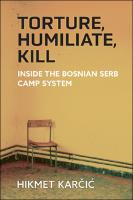Torture, Humiliate, Kill
External Review of Whole Manuscript
Inside the Bosnian Serb Camp System
| dc.contributor.author | Karcic, Hikmet | |
| dc.date.accessioned | 2022-04-15T15:05:12Z | |
| dc.date.available | 2022-04-15T15:05:12Z | |
| dc.date.issued | 2022 | |
| dc.identifier | OCN: 1287024662 | |
| dc.identifier.uri | https://library.oapen.org/handle/20.500.12657/54072 | |
| dc.description.abstract | Half a century after the Holocaust, on European soil, Bosnian Serbs orchestrated a system of concentration camps where they subjected their Bosniak Muslim and Bosnian Croat neighbors to torture, abuse, and killing. Foreign journalists exposed the horrors of the camps in the summer of 1992, sparking worldwide outrage. This exposure, however, did not stop the mass atrocities. Hikmet Karčić shows that the use of camps and detention facilities has been a ubiquitous practice in countless wars and genocides in order to achieve the wartime objectives of perpetrators. Although camps have been used for different strategic purposes, their essential functions are always the same: to inflict torture and lasting trauma on the victims. Torture, Humiliate, Kill develops the author’s collective traumatization theory, which contends that the concentration camps set up by the Bosnian Serb authorities had the primary purpose of inflicting collective trauma on the non-Serb population of Bosnia and Herzegovina. This collective traumatization consisted of excessive use of torture, sexual abuse, humiliation, and killing. The physical and psychological suffering imposed by these methods were seen as a quick and efficient means to establish the Serb “living space.” Karčić argues that this trauma was deliberately intended to deter non-Serbs from ever returning to their pre-war homes. The book centers on multiple examples of experiences at concentration camps in four towns operated by Bosnian Serbs during the war: Prijedor, Bijeljina, Višegrad, and Bileća. Chosen according to their political and geographical position, Karčić demonstrates that these camps were used as tools for the ethno-religious genocidal campaign against non-Serbs. Torture, Humiliate, Kill is a thorough and definitive resource for understanding the function and operation of camps during the Bosnian genocide. | en_US |
| dc.language | English | en_US |
| dc.relation.ispartofseries | Ethnic Conflict: Studies in Nationality, Race, and Culture | en_US |
| dc.subject.classification | thema EDItEUR::J Society and Social Sciences::JP Politics and government | en_US |
| dc.subject.classification | thema EDItEUR::J Society and Social Sciences::JW Warfare and defence::JWX Other warfare and defence issues::JWXK War crimes | en_US |
| dc.subject.classification | thema EDItEUR::J Society and Social Sciences::JP Politics and government::JPV Political control and freedoms::JPVH Human rights, civil rights | en_US |
| dc.subject.classification | thema EDItEUR::N History and Archaeology::NH History::NHD European history | en_US |
| dc.subject.other | Genocide, Holocaust, concentration camps, Bosnia and Herzegovina, Yugoslavia, Serbia, incarceration, detention, killings, mass graves, torture, Bosniaks, Bosnian Muslims, Visegrad, Bijeljina, Bileca, 1992, 1995, refugees, Prijedor, Croatia, mass atrocities | en_US |
| dc.title | Torture, Humiliate, Kill | en_US |
| dc.title.alternative | Inside the Bosnian Serb Camp System | en_US |
| dc.type | book | |
| oapen.identifier.doi | 10.3998/mpub.12079875 | en_US |
| oapen.relation.isPublishedBy | e07ce9b5-7a46-4096-8f0c-bc1920e3d889 | en_US |
| oapen.relation.isFundedBy | b818ba9d-2dd9-4fd7-a364-7f305aef7ee9 | en_US |
| oapen.relation.isbn | 9780472132966 | en_US |
| oapen.relation.isbn | 9780472039043 | en_US |
| oapen.relation.isbn | 9780472129928 | en_US |
| oapen.collection | Knowledge Unlatched (KU) | en_US |
| oapen.imprint | University of Michigan Press | en_US |
| oapen.pages | 276 | en_US |
| oapen.place.publication | Ann Arbor | en_US |
| peerreview.anonymity | Double-anonymised | |
| peerreview.id | d98bf225-990a-4ac4-acf4-fd7bf0dfb00c | |
| peerreview.open.review | No | |
| peerreview.publish.responsibility | Scientific or Editorial Board | |
| peerreview.review.decision | Yes | |
| peerreview.review.stage | Pre-publication | |
| peerreview.review.type | Full text | |
| peerreview.reviewer.type | External peer reviewer | |
| peerreview.title | External Review of Whole Manuscript | |
| oapen.review.comments | The proposal was selected by the acquisitions editor who invited a full manuscript. The full manuscript was reviewed by two external readers using a double-blind process. Based on the acquisitions editor recommendation, the external reviews, and their own analysis, the Executive Committee (Editorial Board) of U-M Press approved the project for publication. |

